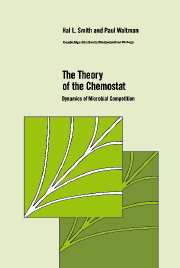Book contents
- Frontmatter
- Contents
- Preface
- 1 The Simple Chemostat
- 2 The General Chemostat
- 3 Competition on Three Trophic Levels
- 4 The Chemostat with an Inhibitor
- 5 The Simple Gradostat
- 6 The General Gradostat
- 7 The Chemostat with Periodic Washout Rate
- 8 Variable-Yield Models
- 9 A Size-Structured Competition Model
- 10 New Directions
- 11 Open Questions
- Appendices
- References
- Author index
- Subject index
10 - New Directions
Published online by Cambridge University Press: 07 December 2009
- Frontmatter
- Contents
- Preface
- 1 The Simple Chemostat
- 2 The General Chemostat
- 3 Competition on Three Trophic Levels
- 4 The Chemostat with an Inhibitor
- 5 The Simple Gradostat
- 6 The General Gradostat
- 7 The Chemostat with Periodic Washout Rate
- 8 Variable-Yield Models
- 9 A Size-Structured Competition Model
- 10 New Directions
- 11 Open Questions
- Appendices
- References
- Author index
- Subject index
Summary
Introduction
In this chapter, several recent models that make use of the chemostat are described. The situations that occur are not as fully understood as those in the previous chapters, and no attempt will be made to present a detailed analysis. The mathematical results are only partial and, in fact, in some cases the modeling is clearly inadequate at this time. The title of the chapter is intended to suggest that further work is needed. The problems are important and interesting, and it is hoped that the reader might find something of interest here and contribute to the development of the theory.
Three types of new directions are discussed. In two of these, ordinary differential equations are not an adequate model to describe the phenomenon of interest; functional differential equations and partial differential equations provide the appropriate setting. In the remaining case ordinary differential equations are appropriate but the modeling is not complete. Improving the model would result in a larger system for which the techniques of monotone dynamical systems are inappropriate. The problems will be described and results indicated, but no proofs are given. In all cases, much more work needs to be done before the problem is appropriately modeled and analyzed.
The Unstirred Chemostat
The gradostat was an attempt to create a nutrient gradient in a piece of laboratory apparatus; it was discussed in detail in Chapters 5 and 6.
- Type
- Chapter
- Information
- The Theory of the ChemostatDynamics of Microbial Competition, pp. 231 - 247Publisher: Cambridge University PressPrint publication year: 1995

